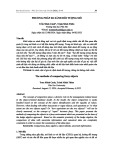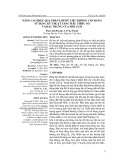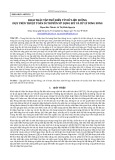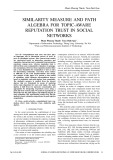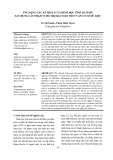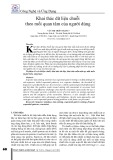
ISSN 1859-1531 - THE UNIVERSITY OF DANANG - JOURNAL OF SCIENCE AND TECHNOLOGY, VOL. 22, NO. 12, 2024 13
APPROACHES TO THERMODYNAMIC PROPERTY CALCULATION OF
COMPLEX FLUIDS: LITERATURE REVIEW
Nguyen Thanh Binh
The University of Danang – University of Science and Technology, Vietnam
*Corresponding author: thb.nguyen@dut.udn.vn
(Received: October 06, 2024; Revised: December 09, 2024; Accepted: December 12, 2024)
DOI: 10.31130/ud-jst.2024.446E
Abstract - Thermophysical properties of industrially complex
fluids whose composition is always ill-defined are in practice
predicted by using thermodynamic models. To ensure the
prediction accurately and reliably, a three-step procedure to
obtain the properties of these fluids must be validated. The focus
of this study is laid on a short review of tools which can be served
for each of the three steps. It should be noted that the tools
presented in this work are centered on the ones applicable for
highly associating and/or polar fluids. It is also recommended in
this work an approach for characterizing a pseudocomponent
representative of a complex mixture, e.g. petroleum fluids,
biomass fluids, considering the available analytical data. This
fully described pseudocomponent can be easily used within any
thermodynamic models.
Key words - Thermodynamic models; equations of state;
parameterization; fluid characterization; pseudocomponent.
1. Introduction
Accurate and reliable knowledge of phase equilibrium
behavior as well as transport properties plays a crucial role
in designing and optimizing chemical and biochemical
processes [1]. However, properties for a given process are
not always obtained by means of experiments, especially
when considering a wide range of working conditions for
fluids involved into the process. Therefore, the lack of
properties is often compensated by having recourse to
mathematical models or equations of state (EoS). To use the
selected equation of state for estimating thermodynamic
properties, it is necessary for an engineer to parameterize the
equation. The purpose of this is to calculate characteristic
parameters which will be used as inputs for the equation.
Yet, the calculation of properties for practically industrial
applications is not easily accessible, even having at hand an
EoS and a suitable parameterization approach. This is due to
the fact that industrial fluids are usually complex fluids that
are composed of a large number of ill-defined components.
Petroleum-based fluids are typical examples of complex
fluids. These fluids typically contain a large range of
different hydrocarbons and non-hydrocarbons whose actual
composition is only partially identified [2]. Biomass-
originated fluids stemming are even more complex than
petroleum-originated ones because they contain large
amounts of oxygen-containing species, such as ketones,
acids, ethers, esters, aldehydes, etc [3]. Therefore, to be able
to determine the characteristic parameters, an accurate
description of complex fluids is needed. This procedure is
called fluid characterization. Figure 1 summarizes a
procedure for calculating thermophysical properties of a
complex fluid of interest.
Figure 1. General procedure for calculating thermophysical
properties of a fluid of interest
As shown in Figure 1, it is crucial to validate three steps
in order to be able to calculate phase equilibrium and
thermodynamic properties for any mixture:
(i) It requires an adequate EoS or a thermodynamic
model for calculating phase equilibrium properties or
transport properties.
(ii) The EoS parameters for each component, which
constitutes the fluid under consideration, must be at hand.
The determination of these parameters should be founded
on the chemical nature of the considered component or be
relied on experimental means.
(iii) To be able to characterize the considered
components, a set of experimental information or
analytical information must exist. This information will be
used to generate so-called pseudocomponents representing
a group of chemical species or representative molecules
[4], as commonly applied in petroleum industry. The aim
of using this technique, often referred to as
“pseudoization”, is to reduce the number of actual
components present in the fluid of interest. This reduction
helps to simplify the calculation and computational cost
with the chosen EoS.
This work will perform a short literature review on each
of the above-mentioned steps. In the second section,
several typical models for thermophysical properties will
be presented and discussed. It should be noted that the
discussion is focused on predictive equations whose
parameters can be purely estimated and on the ones that
can be applied for associating and/or polar molecule -
containing fluids. The third section will present several
parameterization methods which can be used to determine
characteristic inputs. In the next section, we will discuss
various methods used to define pseudocomponents given
the availability of the experimental information. A
conclusion is provided in the final section.
2. Equations of state for property calculation
The equations of state can generally be categorized into
cubic, statistical mechanics-based, and hybrid EoS.

14 Nguyen Thanh Binh
Being first introduced in 1873 by van der Waals [5],
cubic-type equations have since been further modified and
are being widely applied in the oil refining industry. The
detailed description of the cubic EoS as well as their
successful implementation are referred to the works given
by Wei and Sadus [6], Valderrama et al. [7]. In general, the
cubic EoS can be described as the sum of two terms,
namely, the repulsive term accounting for the repulsive
interactions between hard sphere-type molecules and the
attractive term accounting for the attractive interactions
between these hard-sphere molecules. Among the most
advanced EoS in this category, it is worth mentioning
Soave-Redlich-Kwong (SRK) [8] and Peng-Robinson (PR)
[9]. These two cubics are widely applied in the petroleum
refining industry. Equation (1) is the general expression of
the cubic-type equations:
𝑃 = 𝑅𝑇
𝑣−𝑏 −𝑎(𝑇)
(𝑣−𝑟1𝑏)(𝑣−𝑟2𝑏) (1)
where 𝑟1, 𝑟2 can take different values depending upon the
equation, as shown in Table 1; two characteristic
parameters a and b are determined from the critical
properties of fluids considered.
Table 1. Parameters 𝑟1 and 𝑟2 to be used for cubics including
vdW EoS, SRK EoS, and PR EoS
Parameters
vdW
SRK
PR
𝑟1
0
0
−1− √2
𝑟2
0
-1
−1+ √2
The widespread utilization of the cubic EoS is
accounted by (1) it is simple for these equations to be
incorporated into commercial simulation softwares and
(2) only a few characteristic parameters (e.g., a and b are
estimated easily from critical properties) are required for
these equations. However, its limitation appears when
being used to describe strongly non-ideal mixtures which
contain highly polar and/or strongly associating molecules.
Statistical mechanics-based EoS, which allows to
linking of bulk properties with molecular properties, is
demonstrated to be capable of handling complex mixtures
of associating and/or polar molecules. Founded on a solid
physical framework, these EoS allow explaining the
physical nature of fluids, for instance, hydroden-bonding
interactions, chain formation, etc. The so-called
Statistical Associating Fluid Theory (SAFT) equations
are the best examples for this category of EoS. The first
version of SAFT-type EoS was introduced by Chapman
et al. with the use of Wertheim’s perturbation theory for
taking into account associative interactions between
molecules [10], [11]. SAFT is generally expressed as
contributions to the residual Helmholtz energy 𝐴𝑟𝑒𝑠, as
shown in Eq. (2).
𝐴𝑟𝑒𝑠 =(𝑚𝐴ℎ𝑠 +𝐴𝑐ℎ𝑎𝑖𝑛)+𝐴𝑑𝑖𝑠𝑝 +𝐴𝑎𝑠𝑠𝑜𝑐 +𝐴𝑝𝑜𝑙𝑎𝑟 (2)
where 𝐴ℎ𝑠, 𝐴𝑐ℎ𝑎𝑖𝑛, 𝐴𝑑𝑖𝑠𝑝, 𝐴𝑎𝑠𝑠𝑜𝑐, and 𝐴𝑝𝑜𝑙𝑎𝑟 is terms
respectively accounting for contributions from hard-
sphere, chain formation, London attractive interaction,
associative interaction, and polar characteristics. Each term
is characterized by specific parameters such as segment
diameter 𝜎, number of segments m, well-depth energy of
dispersive energy 𝜀/𝑘, association energy 𝜀𝐴𝐵/𝑘 and the
association volume 𝐾𝐴𝐵 (where A and B represent the
associating sites), the polar moment (dipole moment 𝜇 and
quadrupole moment q) and the polar fractions
(𝑚𝑥𝑝𝜇 𝑎𝑛𝑑 𝑚𝑥𝑝𝑄). Since 1989, different versions of
SAFT models have been developed and proposed in
literature [12 - 15]. The main differences among SAFT-
type versions essentially come from either (1) the reference
system considered, or (2) the choice of approach to
describe repulsive and attractive interactions. The use of
SAFT-type equations for thermodynamic behavior of
complex fluids, for both pure compounds and mixtures,
was successfully shown in many investigations [13], [14].
In addition to the two aforementioned equations, many
investigators have also developed the so-called hybrid EoS
which are based on a cubic-type EoS plus an association
term derived from the Wertheim theory [16], [17]. Among
many successful models proposed in the literature, much is
focused on the so-called CPA (Cubic Plus Association)
equation [18] and the GCA (Group Contribution
Associating) equation [19]. To extend the capability of
cubic-type EoS for associating molecules, Kontogeorgis et
al. [18] formulated the CPA equation, which is a
combination of SRK with the association term derived
from SAFT, as shown in Eq. (3).
𝑃 = 𝑅𝑇
𝑣−𝑏 −𝑎
𝑣(𝑣+𝑏)+𝑅𝑇
𝑣𝜌∑[1
𝑋𝐴−1
2]𝜕𝑋𝐴
𝜕𝜌
𝐴 (3)
where 𝑋𝐴 is molar fraction of the compound not-bonded at
site A. The characteristic parameters in Eq. (3) were fitted
against vapor pressure and saturated liquid density
measured values. Successful applications of this model
were demonstrated for mixtures containing light
hydrocarbons, water and alcohols [20 - 22].
In the case of predicting transport properties such as
viscosity, many thermodynamic models have been
proposed with the use of different underlying theories
such as kinetic theory [23], [24], corresponding states
theory [25], free-volume concept [26], friction theory
[27], and among others. These models have been shown
to be capable of predicting the viscosity of industrial
fluids to a reasonable extent [28]. One of the most
prominent models, which has been demonstrated to be
capable of predicting the viscosity of complex fluids, is
the one founded on the kinetic theory of hard sphere. This
equation was firstly presented by Dymond [29] and then
refined for practical applications by Assael et al. [23], as
shown in Eqs. (4) & (5).
𝑙𝑜𝑔(𝜂∗
𝑅𝜂) = ∑𝑎𝜂𝑖
7
𝑖=0 (𝑉∗)𝑖 (4)
𝜂∗=16
5(2𝑁𝐴)1/3 (𝜋
𝑀𝑅𝑇)1/2 𝑉𝑚
2/3
𝑅𝜂𝜂 (5)
where 𝑉𝑚, 𝑉𝑜, 𝑀, 𝑅, 𝑇, 𝑅𝜂 and 𝜂 corresponds to the molar
volume, the molar core volume, the molar mass, the
universal gas constant, the temperature, the roughness
factor, and the dynamic viscosity, respectively. The
extension of this scheme was applied to predict the
viscosity of different complex fluids (synthetic crude oils,
aromatics, etc) within an uncertainty of 5% [24], [30].

ISSN 1859-1531 - THE UNIVERSITY OF DANANG - JOURNAL OF SCIENCE AND TECHNOLOGY, VOL. 22, NO. 12, 2024 15
3. Parameterization techniques
As clearly shown in Figure 1, the application of any
thermodynamic model should define their characteristic
parameters. This step is called “parameterization”. There
are four techniques commonly used to parameterize an
equation of state or a thermodynamic model. These
techniques are mainly classified into regression,
corresponding states principle, ab initio calculations, group
contribution. The following paragraph will present and
discuss briefly these techniques.
Direct regression on experimental data is the safest
technique to determine characteristic parameters. The use
of the parameters obtained by this technique accurately
restores properties which are used for the regression.
Nevertheless, the extrapolation of these parameters for
other applications strongly depends on the physical
framework of the model and also the condition range of the
database used for the regression. A difficulty with this
approach lies in the fact that parameters are very often
regressed against pure experimental data. Therefore,
extending these regressed parameters to mixtures could
reach a severe deviation in predictive results. To overcome
this difficulty, spectroscopic data for associatiion-relating
parameters or mixture data can be included in the database
used for the regression, as done by von Solms et al. [31] or
Ferrando et al. [32].
Another method for parameterizing cubic-type EoS is
the corresponding states one [33 - 35]. This well-known
principle is based on using properties at critical points and
acentric factors to estimate EoS characteristic parameters.
Therefore, this technique allows to capture exactly fluid
behavior at the critical point. Bouza et al. [36] applied this
technique to a SAFT-type equation. Consequently,
critical points were well captured, but high deviations
were still observed elsewhere. This indicates that the
corresponding state principle is not suitable to
parameterize molecular equations of state like SAFT.
This principle was also applied to the transport property
model [37 - 40].
The ab initio (quantum mechanical) calculations were
used to parameterize SAFT-type EoS by several research
groups [41 - 45]. A drawback when using this technique is
that the number of compounds considered is limited due to
the fact that the computational expense for molecules under
consideration is costly.
Another technique which allows to determination of
EoS parameters is the Group Contribution (GC) method.
To be able to use this technique, the chemical structure of
a molecule considered, or more precisely, its molecular
functional groups such as CH3-, -CH2-, -NH2-, -COOH,
etc must be established. Several GC-based approaches
were developed for parameterizing cubic EoS, for
instance, the well-known Predictive Soave-Redlich-
Kwong model [46], which is a combination of SRK with
an activity coefficient approach based on the GC
technique used to predict the attractive mixture
parameter. Based on the PR EoS framework, Jaubert et
al. [47] developed a GC scheme to estimate the so-called
binary interaction parameter kij. The working groups of
Brignole [48] and Stefanis et al. [49] also proposed the
GC rules for associating compounds. The so-called GCA
EoS, combining the GC scheme developed by Skjold-
Jorgensen [50] and Wertheim’s theory-based association
term, was successfully applied to systems of fatty oil
derivatives and pure organic compounds. The application
of GC techniques for SAFT-type EoS is generally
classified into two approaches, namely, homonuclear GC
approach and heteronuclear GC approach. Regarding the
homonuclear approach, the groups of Passarello and de
Hemptinne proposed the average mixing rules for the
three non-associating parameters (𝜀/𝑘, 𝜎, 𝑚) of the
original SAFT and PC-SAFT [51], [52]. The polar
version of the PC-SAFT combined with the GC approach
was successfully applied to alkanes, alcohols, aromatic
hydrocabons, oxygenated compounds [53]. Among the
heteronuclear GC approaches, the prominent one is the
scheme proposed by Lymperiadis et al. [54], [55]. This
scheme, which relied on SAFT-VR, was successfully
applied for pure alkanes, pure alcohols, as well as their
mixtures [56]. Recently, the GC technique was also
developed for viscosity on the basis of the cubic EoS,
presented by Cardona et al. [57], and of the free-volume
theory model, presented by Jovanovic et al. [58], with
encouraging results.
4. Fluid characterization approaches
To perform thermophysical property calculations with
a thermodynamic model, a description of fluid is
indispensable. With regard to petroleum refining
applications, ill-defined mixtures are often described
through a set of pseudocomponents. According to Khan
et al. [59], the fluid description has to answer four
following questions: (1) “How many components should
be used?”, (2) “How should pseudocomponents be
formed?”. (3) “How should fluid characterization
parameters be obtained?”, and finally (4) “Which mixing
rules should be used to calculate pseudo-properties?”.
The first issue is related to the analysis in terms of
composition and property measurements of fluids under
investigation. The analytical information obtained for the
fluids will decide which approaches can be used to create
a set of pseudocomponents. This section will review some
of the most commonly used methods for fluid
characterization. The information on these methods will
be organized in order as follows input data, data
treatment, and finally fluid characterization.
4.1. Utilization of distillation curves
In the field of petroleum refining, it is impossible to
access a full analysis of molecular components for
petroleum mixtures. Therefore, these multi-component
fluids are commonly described through a set of
pseudocomponents which are also assigned
thermophysical properties. The application of the
pseudocomponent concept aims at reducing the actual
number of molecular components being used in simulation
softwares. This results in simplifying the calculation
operations with a chosen EoS.

16 Nguyen Thanh Binh
4.1.1. Input data
Conventionally, pseudocomponents are generated from
distillation curves [60] which are built up from
experiments. Distillation is referred to as a separation
technique of liquid mixtures or liquefied gas mixtures into
individual components or groups of components (aka
fractions or cuts termed in the refining field) thanks to the
volatility difference between chemical components. The
output of this molecular separation normally is a curve
showing the relationship between boiling temperature and
distilled volume percent. Figure 2 is an example of a
distillation curve for crude oil, where the X-axis is
cumulative liquid volume percent and the Y-axis boiling
temperature.
Figure 2. Typical True Boiling Point curve for a crude oil
There are different norms for building up distillation
curves in the refining industry, for instance, the so-called
true-boiling-point (TPB) curve built up according to
ASTM D2892 standardized for crude oil, or distillation
curves obtained from ASTM D86 standardized for
petroleum products, etc. Distillation curves can also be
obtained by using a gas chromatographic technique
(ASTM D2887). These curves are called simulated
distillation curves. In practice, obtaining TPB curves is
very time-consuming. Therefore, various approaches were
developed to obtain these curves from data provided by
other norms. Readers are referred to references for more
information [61 - 64].
4.1.2. Treatment
As shown in Figure 2, a set of pseudocomponents is
generated by cutting the TBP curve of the fluid into
different temperature intervals. The smaller the
temperature intervals, the more accurate the representation
will be. Practically, adequate temperature interval ranges
from 10 to 15 degrees Kelvin [65]. Each pseudocomponent
defined from the TBP curve is then characterized by an
average boiling temperature and density. These properties
can be easily and rapidly measured in laboratories. When
petroleum fractions cannot be collected and no actual
measurement is possible, the density of the fractions is then
calculated assuming that the characterization factor Kw
[66] is constant throughout the fractions. This factor
measures the “paraffinicity” of hydrocarbons. It is defined
as the ratio of the cube root of the average boiling point
(Tb) and specific gravity (SG) of petroleum fractions, as
shown in Eq. (6).
𝐾𝑤=(1.8𝑇𝑏)1/3
𝑆𝐺 (6)
A petroleum fraction behaves as kinds of paraffin if the
value of Kw is approximately 13 and as aromatics if Kw is
approximately 10.
4.1.3. Characterization
Based on Tb and SG, some properties (e.g., critical
temperature and pressure, acentric factor) of the
pseudocomponents can be calculated by utilizing adequate
correlations, for instance, those proposed by Lee and
Kesler [35], but many others can be found in the literature
[2], [67].
The fluid characterization as pseudocomponents is
widely used as a basic approach in many commercial
simulation software like HYSYS, Aspen Plus, Pro/II, etc
to simulate and design separation processes such as crude
oil distillation. The benefits of using this technique lie in
the fact that (1) molecular information is not needed; only
bulk properties such as Tb and SG are required, and (2)
the number of components being simultaneously treated
is considerably reduced. Although being able to meet
refiners’ simulation demands, and being still a prevailing
technique in simulating refining processes today, this
approach, according to Eckert and Vanëk [68], has some
inevitable limitations. Most importantly, this technique is
incapable of considering the wealth of complexity in non-
petroleum based fluids, for instance, those originating
from biomass processing. This is due to the fact that the
input information needed for characterization purposes
almost exclusively refers to fluid volatility.
4.2. Utilization of lumping approach
Fluids can be characterized by several hypothetical
groups by using a lumping technique. By using this
technique, components possessing one or a few similar
physical properties (e.g., critical temperature and pressure,
acentric factor, molecular weight, etc) will be lumped or
grouped into a hypothetical group.
4.2.1. Input data
Contrary to the above-mentioned the
pseudocomponent-based approach, the lumping
technique requires a detailed analysis of all fluid
components. Thanks to modern analytical instruments
such as chromatography, spectroscopy, spectrometry, etc,
the information on composition (weight or molar percent)
and molecular structure for a large range of components
in fluids, particularly for petroleum fluids, is accessible.
Readers are referred to references [2], [69] for more
information. Regarding fluids originating from biomass
processing, recent developments in the so-called two-
dimensional gas chromatography technique (GC-2D)
make it possible to consider oxygenated bio-oils [70],
[71]. The description of this modern technique is detailed
in some reviews [72], [73].

ISSN 1859-1531 - THE UNIVERSITY OF DANANG - JOURNAL OF SCIENCE AND TECHNOLOGY, VOL. 22, NO. 12, 2024 17
4.2.2. Treatment
On the basis of detailed molecular information of a
fluid under consideration, it is possible to group the fluid
components into a limited number of hypothetical
components or pseudocomponent. The algorithm proposed
by Montel and Gouel [74], also known as the dynamic
cloud method, is the most frequently used for lumping
purpose. Within this algorithm, several thermophysical
properties as input data will be provided for each
component together with a corresponding weight factor for
each property used. The lumping algorithm will then
identify a number of hypothetical groups by minimizing
the objective function expressed as dij (see Eq. (7)). This
value is defined as the distance between barycenters (i.e.,
centers of lumps) of hypothetical groups and the
components belonging to these hypothetical groups for all
properties considered.
𝑑𝑖𝑗 =∑𝑤𝑘|𝑟𝑖,𝑘
2−𝑟𝑗,𝑘
2|
𝑛𝑝𝑟𝑜𝑝𝑒𝑟𝑡𝑖𝑒𝑠
𝑘=1 (7)
Where dij is the distance between compound i and j; wk is
the weighting factor for property k; ri,k is the normalized
value of property k of compound i. This value is
normalized between the minimum and maximum values of
property k of compound i on all the compounds.
Figure 3. Algorithm of the lumping scheme [74]
Basically, the lumping algorithm consists of 4 steps as
illustrated in Figure 3. The first step involves random
selection of the quantity of lumps and barycenters. In the
next step, components are distributed into the lumps based
on their nearest distance criterion (see Eq. (7)). Note that
the criterion can be one or many properties, as well as
specific parameters of an EoS. The barycenters are then
determined for each lump based on the distribution
procedure done in the second step. In the third step, the
distribution of the components will be done iteratively until
all barycenters achieve stability, which means that no
component moves to another lump [65]. Consequently, the
output of this algorithm is a distribution of the initial
components in the chosen number of lumps.
4.2.3. Characterization
The properties or EoS specific parameters need
determining for each lump. To that end, an averaging rule
based on the properties of the lump-belonging components
is used. Averaging rules for determining critical properties,
molecular weight, and acentric factors for a lump are given
as examples in references [74], [75]. As a result, the well-
defined lumps can be used as pure components within the
framework of the chosen EoS. It should be noted that the
lumps generated from this technique can be considered as
pseudocomponents in the same way as discussed above. A
challenge with using this approach is to identify lumping
criteria. That involves the determination of relevant
properties used in the objective function.
4.3. Utilization of solvent fractionation approaches
Petroleum fluids, mainly residues, are often
characterized by using a solvent-based fractionation
approach. The fractionation is achieved due to the variation
in terms of solubility and polarity of components of the
fluids into different solvents. Basically, this technique
utilizes various chemical solvents to fractionate mixtures
into different chemical families each of which is treated as
a pseudocomponent. A typical illustration of this method is
the so-called SARA method which fractionates a crude oil
into 4 fractions including Saturates (S), Aromatics (A),
Resins (R) and Asphaltenes (A), using solvents including
n-heptane, acetone, dimethylformamide [2].
4.3.1. Input data
Various research groups developed their solvent
fractionation technique for oxygenated bio-oils
originating from biomass processing [76]. Generally, a
solvent fractionation strategy for bio-oils involves two
steps. Firstly, bio-oils are fractionated by using different
solvents. This procedure aims at separating the bio-oils
into fractions of different characteristics (e.g., solubility,
polarity). The second step of the fractionation strategy
involves identifying the chemical composition of the
fractionated fractions. The recent developments of modern
analytical instruments facilitate the detailed identification
of the chemical composition of oil fractions even when
only small amounts are available. Chromatographic (both
gas and liquid), spectroscopic methods, gas
chromatography – mass spectrometry, GC2D – MS or
NMR are widely used for fractions obtained from the
solvent-based fractionation technique [77]. Several two-
step approaches developed for characterizing pyrolysed
oils are presented in references [78 - 81].
4.3.2. Treatment
Like the abovementioned SARA method, each fraction
obtained from the solvent fractionation approach can be
treated as a pseudocomponent.
4.3.3. Characterization
To compute thermodynamic properties with an EoS, it
requires the availability of several characteristic
parameters (i.e., Tc, Pc, 𝜔) for each of the fractionated



